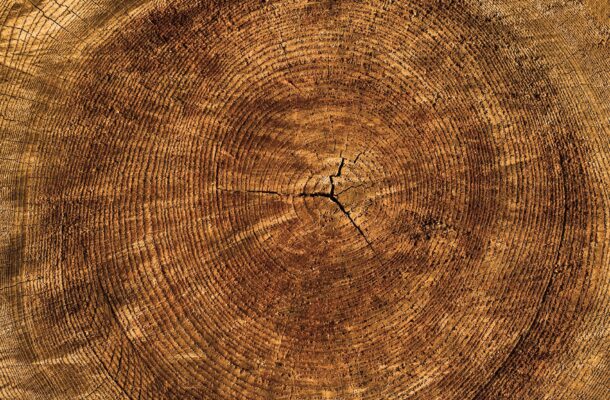The deep roots of history

Dendrochronology is the study of tree rings and how they are affected by climate. Since all trees in a given area are affected in roughly the same way, the rings can be compared. This means that the rings in a newly felled tree can be compared with those of a much older one – by locating similar rings and working backwards in time.
Using this method, accurate climactic measurements have been made for the last 10,000 years using timber found in bogs and even mummified timber found in the arctic. Many species of trees, especially those in temperate climates, lay down a new ring each year that reads like a barcode of its age.
These markers of time also help scientists pin down when the tree absorbed radioactive carbon-14, produced by the interaction of high energy particles, caused by cosmic rays and solar storms interacting with the atmosphere.
When high-energy radiation strikes the upper atmosphere it turns nitrogen atoms into radioactive carbon-14, or radiocarbon. The radiocarbon then filters through the air and the oceans, into sediments and bogs and carbon based lifeforms.
Carbon-14 degrades at a known rate and hence the original strength can be determined if the time of introduction is known. This means the rise and fall of carbon-14 levels in tree rings encodes a history of the 11-year cycle of the solar dynamo (which creates the Sun’s magnetic field) and the reversals of Earth’s magnetic field.
But tree rings also record events we cannot presently explain. In 2012, Japanese physicist Fusa Miyake discovered a spike in the radiocarbon content of tree rings from 774 AD. It was so big that several ordinary years’ worth of cosmic rays must have arrived all at once. Many of the spikes lasted longer than normal solar storms. At least one event in 663 BC lasted up to three years, and another in 5480 BC built up across a decade.
As more teams have joined the search, tree ring evidence has been uncovered of further “Miyake events”: from 993 AD and 663 BC, and prehistoric events in 5259 BC, 5410 BC, and 7176 BC.
These have already led to a revolution in archaeology. Finding one of these short, sharp spikes in an ancient sample pins its date down to a single year, instead of the decades or centuries of uncertainty from ordinary radiocarbon dating.
These events can arrive at any point in the Sun’s 11-year activity cycle. Solar flares, on the other hand, tend to happen around the peak of the cycle. The most intense solar storm in recorded history, known as the Carrington event, damaged nascent power and communication networks in the Victorian era. But Earth has been hit by radiation levels that were up to 100 times greater than this.
Storms from the Sun
Solar storms come in two broad categories. One type is a solar flare, an immensely powerful explosion on the Sun’s surface that is extremely bright in high-energy gamma and X-rays.
Another is a coronal mass ejection, or CME, which is when a huge area above the Sun blasts up to a billion tons of subatomic particles away at speeds of millions of kilometers per hour. Both are generated by the Sun’s magnetic field, which can store tremendous energy, and sometimes a flare is followed by a CME.
A huge solar flare erupted on the Sun in October 2003. It was also accompanied by a powerful coronal mass ejection. Solar storms like these are a danger to our power grid and orbiting satellites.
Both can wreak havoc on Earth. A truly big eruption from the Sun aimed our way would be disastrous for our modern civilization. It could wipe out satellites, cause electronics damage on the ground, and also create widespread power outages by taking down the electric power grid. A severe storm could leave large swaths of humanity without power for a long time, months or more. It would be catastrophic.
We’ve seen a handful of storms this big in modern times. In 1989 a solar event blew out transformers in Canada, causing a power outage in Quebec. Another in 1859, called the Carrington Event, ushered in the modern era of studying solar storms.
There was one in 1956 so powerful it’s now used as a baseline for measuring the effects of storms on Earth. A truly massive CME erupted from the Sun in 2012, but missed the Earth. It is no exaggeration to say that had it been aimed right at us it could have been the biggest catastrophe of the modern age.
How far back can we go?
How far back can dendrochronology take us? About 45 million years ago, when the Arctic was ice-free, the world’s earliest known mummified trees flourished on what is now Axel Heiberg Island in Canada’s Qikiqtaaluk Region. In 1986, palaeobotanists identified the megaflora as members of Metasequoia occidentalis, an extinct redwood species. They had been buried in silt, then frozen, their wood preserved.
The lead palaeontologist “celebrated his eureka by kindling a fire with 45-million-year-old twigs and boiling water for tea time,” writes historian Jared Farmer in Elderflora, his expansive global history of grand and venerable trees.
Granted, these plants had been dead since the Eocene epoch. Nevertheless, as the author describes, the incident is part of a troubling pattern in which scientists rejoice at their discovery of the ‘oldest’ tree of their time — and then destroy it.
In 1957, for example, Edmund Schulman at the University of Arizona in Tucson spent the summer seeking ancient bristlecone pines in California’s White Mountains. He found three more than 4,000 years old, and named them Alpha, Beta and Gamma.
Then, in the interests of tree-ring science, he chose to “sacrifice” Alpha, taking snapshots as his nephew and a colleague sawed it down. When the University of Arizona issued a press release titled ‘UA Finds Oldest Living Thing’, Farmer writes, “they say nothing about the thing being dead”.
A quick look at history around some of the events discussed written by monks in Britain and scribes in China indicates that there was a marked increase in combat at those times, although this is not necessarily connected. We should note that mental hospitals have more problems with patients during electrical storms.

Alan Stevenson spent four years in the Royal Australian Navy; four years at a seminary in Brisbane and the rest of his life in computers as an operator, programmer and systems analyst. His interests include popular science, travel, philosophy and writing for Open Forum.












